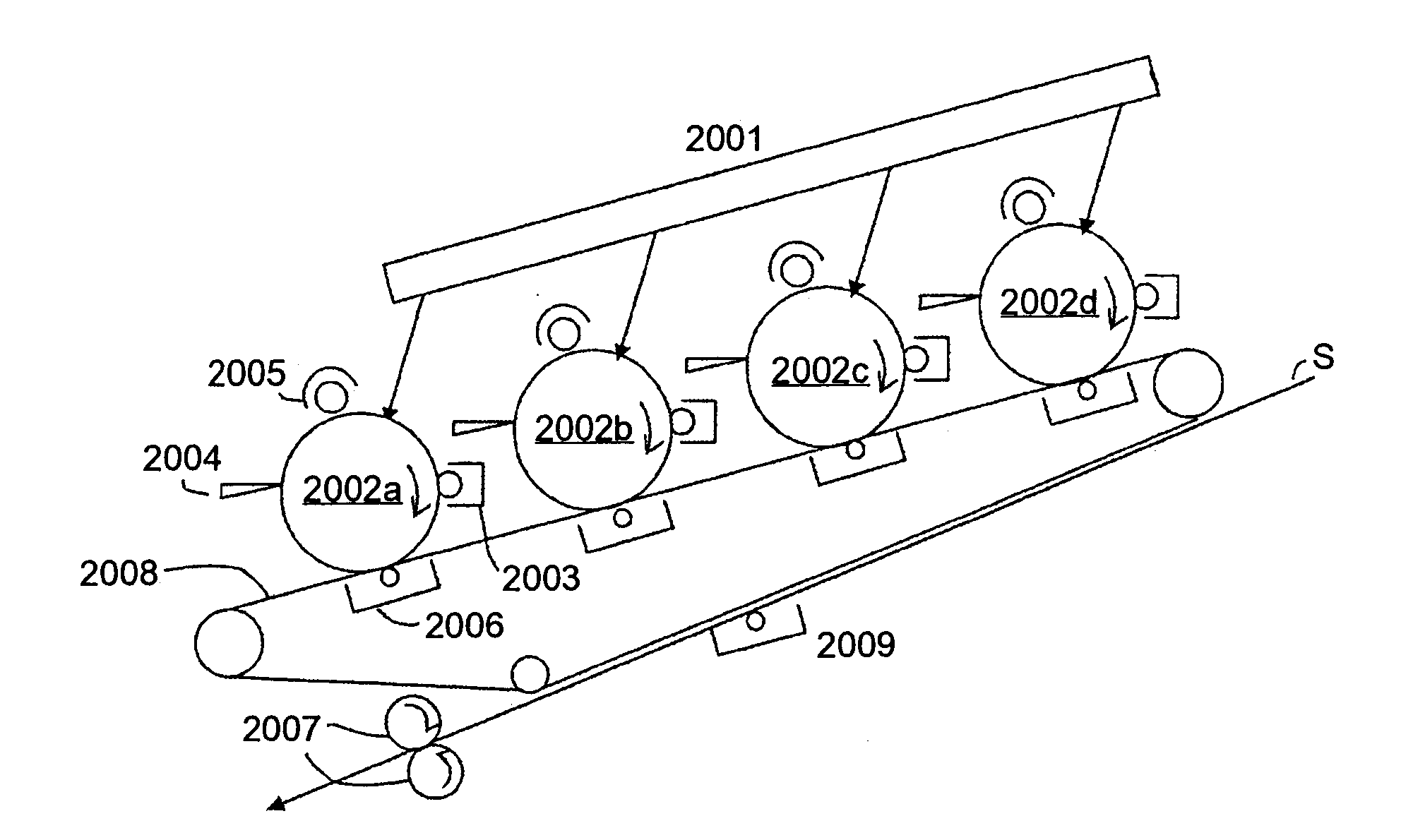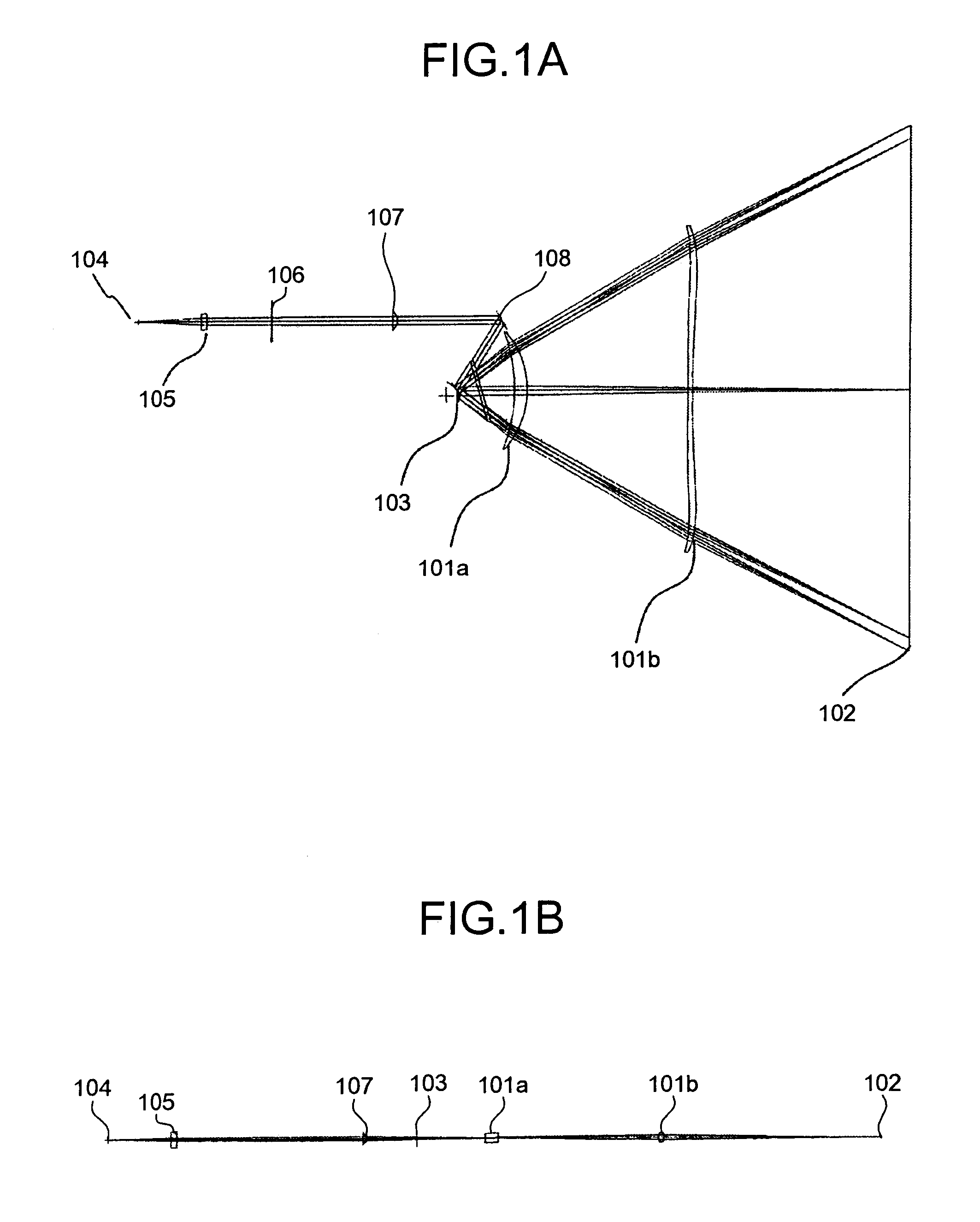Optical scanning device and image forming apparatus
a scanning device and image forming technology, applied in the direction of electrographic process apparatus, instruments, printing, etc., can solve the problems of increasing power consumption and noise, heat generation, degradation of durability, and unstable properties, and it is difficult to ensure the optical characteristics of the entire light flux
- Summary
- Abstract
- Description
- Claims
- Application Information
AI Technical Summary
Benefits of technology
Problems solved by technology
Method used
Image
Examples
first embodiment
[0046]FIGS. 1A and 1B depict optical arrangement of an optical scanning device according to the present invention. More specifically, FIG. 1A depicts the optical arrangement in a main-scanning plane, and FIG. 1B depicts that in a sub-scanning plane. The optical scanning device has an incident optical system including a light source 104, a coupling lens 105, an aperture 106, and a linear-image forming lens 107. The optical scanning device also has a scanning optical system including a first scanning lens 101a and a second scanning lens 102b. An optical deflector 103 is provided between the incident optical system and the scanning optical system. An incident mirror 108 is arranged in the incident optical system to cause light flux to enter a deflection reflecting surface of the optical deflector 103 at an appropriate angle.
[0047]In FIGS. 1A and 1B, the coupling lens 105 couples divergent light beams emitted from the light source 104 into substantially parallel light flux for optical e...
third embodiment
[0071]FIGS. 8A and 8B represent modifications of the In FIG. 8A, the parallelograms each having the minimum area are indicated by the solid line and the dotted line, respectively. However, in both cases, there is no light emitting point at each acute angle of the two parallelograms. In this manner, the light emitting points helping the optical scanning are not provided near locations of the vertexes of the acute angles, among the vertexes of the parallelogram, i.e., locations arranged farthest from the optical axis. Therefore, the light beams such that intervals between scanning lines easily vary can be removed, and thus satisfactory optical scanning can be performed with any ones of the light fluxes. The light emitting point to be removed may be one point on each acute angle of the parallelogram (see FIG. 8A), or a plurality of points around each acute angle may be removed (see FIGS. 7 and 8B). The parallelogram surrounding the light emitting points may be one being long in the ma...
fourth embodiment
[0086]The light source 1 (1′) is a semiconductor laser with a light emission wavelength of 655 nanometers in design. If the temperature rises 1° C. from a reference temperature of 25° C., then the light emission wavelength shifts to the long wavelength side by 0.20 nanometer. As for the mode hopping, as explained above, it is assumed that the wavelength change is 0.8 nanometer. In the fourth embodiment, as shown in FIG. 10, two semiconductor lasers each having one light emitting point are provided. However, a semiconductor laser array or a VCSEL array can also be used.
[0087]Coupling Lens
[0088]The coupling lens 2 (2′) is a glass lens as explained above, and is disposed so that the lens has a focal length of 15 millimeters and has a function of converting the light beam to substantially parallel light beam. The aspheric surface is used for both surfaces of the coupling lens 2 (2′), so that the aspheric surfaces satisfactorily correct the wavefront aberration of coupled light beam alth...
PUM
 Login to View More
Login to View More Abstract
Description
Claims
Application Information
 Login to View More
Login to View More - R&D
- Intellectual Property
- Life Sciences
- Materials
- Tech Scout
- Unparalleled Data Quality
- Higher Quality Content
- 60% Fewer Hallucinations
Browse by: Latest US Patents, China's latest patents, Technical Efficacy Thesaurus, Application Domain, Technology Topic, Popular Technical Reports.
© 2025 PatSnap. All rights reserved.Legal|Privacy policy|Modern Slavery Act Transparency Statement|Sitemap|About US| Contact US: help@patsnap.com



